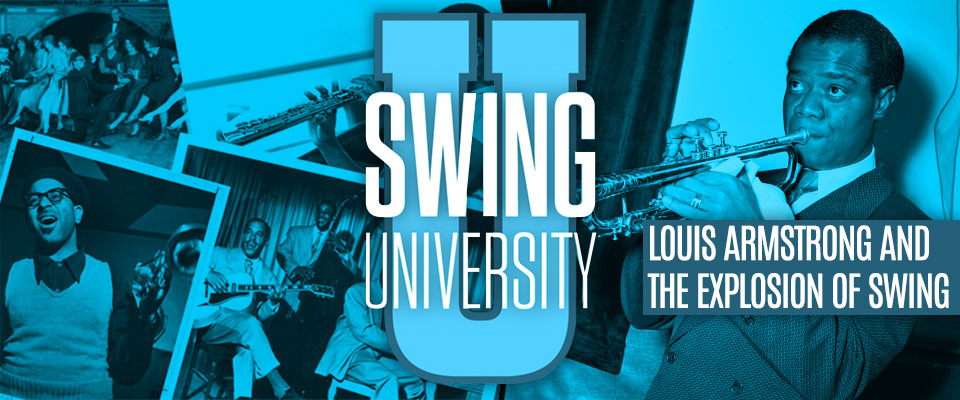
Louis Armstrong and the Explosion of Swing
Part of United We Swing: Jazz and American History
We open our series by celebrating the most influential musician of the 20th century: Louis Armstrong. His peerless trumpet work, his effortlessly swinging vocal work, and his supreme genius provided the 1920s with a road map for expanding popular music into the exciting and diverse array of sounds we hear today. In doing so, Armstrong also shined a light of black genius onto a deeply segregated America.
If you use Spotify, you can listen to a playlist of the music Seton featured in his discussion HERE.
You can also listen through the YouTube playlist on this page; simply click the play button on the video above. Or if you want to listen to an individual song, click on a title in Seton's notes below!
- Chimes Blues – King Oliver’s Creole Jazz Band - April 5, 1923
- What we’re hearing: Louis Armstrong’s first recorded solo!
- Sugar Foot Stomp – Fletcher Henderson Orchestra - May 29, 1925
- Bravura soloing by Louis Armstrong inspiring the dance orchestra of Fletcher Henderson’s to swing fluidly.
- Heebie Jeebies
- Louis Armstrong (cornet, vocal) Kid Ory (trombone) Johnny Dodds (clarinet) Lil Armstrong (piano) Johnny St. Cyr (banjo)
- Chicago, February 26, 1926
- What we’re listening for: Louis singing! He will sing the chorus of the song, and then transition into an improvised singing style called scat singing
- Potato Head Blues
- Louis Armstrong (cornet) John Thomas (trombone) Johnny Dodds (clarinet) Lil Armstrong (piano) Johnny St. Cyr (banjo) Pete Briggs (tuba) Baby Dodds (drums)
- Chicago, May 10, 1927
- What we’re listening for: By 1927, Louis is no longer recording with acoustic technology, but microphones! His Hot Five set up expands to seven (the Hot Seven), as tuba and drums are added. Louis’ solo towards the end of this piece became the stuff of legend
- West End Blues
- Louis Armstrong (trumpet, vocal) Fred Robinson (trombone) Jimmy Strong (clarinet) Earl Hines (piano) Mancy Carr (banjo) Zutty Singleton (drums)
- Chicago, June 28, 1928
- What we’re listening for: Louis now on trumpet in complete command of the instrument, transforming a King Oliver piece. The arrival of Earl Hines’ piano also gives Louis the perfect soloing foil, and the two artists push each other to greater heights
- I Can’t Give You Anything But Love
- Louis Armstrong (trumpet, vocal) J.C. Higginbotham (trombone) Albert Nicholas, Charlie Holmes (clarinet, alto sax) Teddy Hill (tenor sax) Luis Russell (piano) Eddie Condon (banjo) Lonnie Johnson (g) George "Pops" Foster (b) Paul Barbarin (drums)
- New York, March 5, 1929
- What we’re listening for: a smoother ballad sound, pretty rhythm section pulses, and lush singing from Louis. This was a shocker to his longer time fans, and signaled that Louis was moving into a broader, crossover success!
- Blue Yodel No. 9
- Jimmie Rodgers (vocal, guitar), Louis Armstrong (trumpet), Lil Hardin Armstrong (piano)
- Hollywood, CA, July 16, 1930
- What we’re listening for: a melding of the country style of Jimmie Rodgers with Armstrong’s blues-drenched soloing!
Part of the United We Swing: Jazz and American History series presented by Jazz at Lincoln Center.
Individuals with disabilities are encouraged to attend all University of Iowa sponsored events. If you are a person with a disability who requires a reasonable accommodation in order to participate in this program, please contact Paris Young in advance at (319) 467-4849 or at paris-sissel@uiowa.edu.

